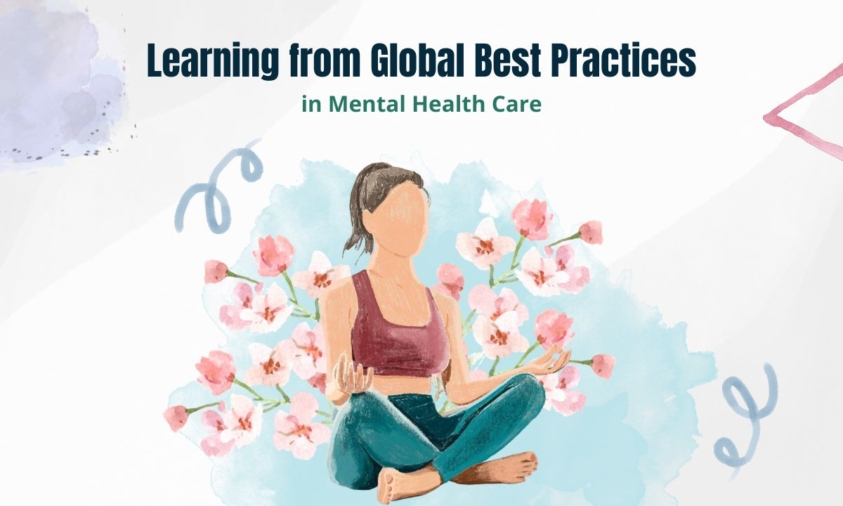Discovering global mental health best practices to improve access, reduce stigma, and strengthen India’s mental health care.
“Just like hitting the gym keeps your body strong, caring for your mind daily keeps your mental health resilient and thriving!”
INTRODUCTION
Everywhere and to everyone, mental health is vital. The need for mental health services is great worldwide, yet the answers are insufficient. Mental health is a fundamental aspect of overall well-being and a basic human right. Good mental health enables one to connect, function, cope, and thrive. It exists on a broad spectrum, ranging from peak well-being to severe distress and emotional suffering. Many barriers prevent people from seeking help for mental health issues, including inadequate services, limited mental health awareness, and stigma. In several regions, formal mental health services are either unavailable, inaccessible, or too costly. Even when help is an option, many individuals endure distress in silence rather than face the discrimination and social exclusion associated with seeking mental health support.
INDIAN CASE STUDY- VISHRAM: A Community Initiative to Prevent Suicides in Rural India
The Vidarbha Stress and Health Program (VISHRAM) was an 18-month initiative (2014–2015) aimed at reducing suicide risk in rural Amravati, Vidarbha. By its conclusion, suicidal thoughts had halved, depression rates dropped by 22%, and mental health care seekers increased six-fold.
Using a tiered care model, community health workers raised awareness, identified individuals with depression, and connected them to lay counselors or psychiatrists for treatment. As a lasting impact, all 30 participating villages now have trained health workers, and 26 village councils petitioned the State Government for better mental health services. VISHRAM highlights the power of community-driven mental health care, reducing stigma and improving access to treatment in rural India.
GLOBAL PRACTICES FOR PACIFYING MENTAL HEALTH
- Proactive Case Detection in Mental Health Awareness
Awareness-building efforts also include proactive case detection. Research in rural Nepal found that trained community volunteers using a vignette- and picture-based detection tool could identify individuals with mental health conditions and inform them about available care. The study revealed that proactive community case detection led to nearly 50% more people seeking mental health treatment compared to general awareness campaigns and self-referrals, highlighting its effectiveness in improving access to care.1
- Digital Technologies for Mental Health
Digital tools like websites, apps, and telemedicine enhance mental health care by improving access, flexibility, and anonymity, reducing costs and stigma. However, concerns like privacy, data security, and screen-time effects must be addressed ethically. Despite risks, research shows that self-help tools and telemedicine are highly effective, even in middle-income countries, making digital solutions vital for universal mental health coverage.
- Recovery Colleges: Education-Based Mental Health Support
Recovery colleges support individuals with mental health conditions through education rather than treatment. Courses cover mental health awareness, recovery strategies, self-care skills, and life development. A key feature is co-production, where people with lived experience help design and deliver programs.
Studies show these colleges reduce reliance on mental health services, empowering individuals to manage their well-being. They also benefit staff by fostering co-production, shifting perceptions, and boosting motivation. At a societal level, recovery colleges promote inclusion and help reduce stigma through shared learning experiences.
- The A-B-C Campaign for Mental Well-being
Australia’s Act-Belong-Commit (A-B-C) campaign promotes proactive mental health through three key steps: staying active (Act), building connections (Belong), and finding purpose (Commit). Supported by online resources and community programs, it strengthens social ties and encourages participation in activities that boost mental health.
With over 160 partners in Western Australia and international adaptations, the campaign reached 82% awareness by 2018, prompting 16% to take action. Its school program trained teachers in 51 schools, benefiting 46,000 students.2
- Sports-Based Life Skills Program in Hong Kong
A sports-based youth program in Hong Kong SAR helps adolescents develop life skills and empowerment through weekly after-school mentoring sessions. Instead of a fixed curriculum, mentors guide students in goal-setting, skill-building, and self-reflection, fostering resilience and problem-solving within a supportive environment.
A rigorous evaluation found the program not only enhanced physical fitness but also boosted mental well-being, self-efficacy, and resilience.
- Suicide Prevention Efforts in Guyana
Since 2014, Guyana has prioritized suicide prevention through national mental health plans led by the Ministry of Public Health. In 2015, the Pan American Health Organization (PAHO) launched training for primary health care providers on suicide risk management and follow-up care, using an online course based on WHO’s mhGAP-IG.
To date, over 300 health workers, including primary care doctors, have been trained. Additionally, gatekeeper training is being introduced to equip teachers and informal caregivers to identify and refer at-risk children and adolescents for support.3
CONCLUSION: LESSONS FOR INDIA
India can strengthen its mental health framework by adopting global best practices. Proactive case detection, as seen in Nepal, can improve early intervention. Digital solutions and recovery colleges offer accessible, education-based support. Community-driven campaigns like Australia’s A-B-C model and Hong Kong’s youth programs highlight engagement and resilience-building. Guyana’s structured suicide prevention policies underscore the need for trained mental health professionals.
By integrating early detection, digital tools, education, and community engagement, India can enhance mental health care, reduce stigma, and improve accessibility.
Authored by Tanvi Ojha, Legal Intern


 Cart is empty
Cart is empty 
